CHAPTER 11
THE FINAL YEARS
1983-93
None of the major manufacturers offered new mobile telephone models after 1982. They were gearing up to provide cellular equipment instead. What IMTS equipment they offered after 1982 was their existing 1970's design equipment, in some cases with more modern looking control heads, or modified and upgraded to operate with a cellular package, so that both modes were available from a single handset. During the late 1980's and early 1990's, a few small firms produced specialized IMTS radios in small quantities, which filled in the gap left by the departure of Motorola and GE. In some cases, specifically the hand-held portables, these IMTS radios were not true IMTS mobiles at all, but just conventional mobile radios which had been modified to provide duplex operation and IMTS signaling, or were half duplex (see Yaesu example below.)
YAESU TRAVELER HANDHELD IMTS:
An interesting "portable" IMTS telephone was introduced by the Japanese company Yaesu in 1982. It was called the "Traveler IMTS" and was available in either VHF or UHF versions. Built on the platform of the commercial FTC-2205 handheld radio, the Traveler was capable of operation on either RCC or Bell System frequencies, in either the MTS or IMTS formats, or the proprietary "SMART" format developed by Secode (not used by the Bell System.) The unit was not full duplex, and not really IMTS capable at all. What the unit actually did, was it sent IMTS signaling without requiring certain acknowledge tones from the central office before proceeding further, as a conventional mobile would. In other words, the Traveler "fooled" the telephone company base station into believing it was talking with a conventional IMTS mobile unit, and assumed that the station was sending the various acknowledge tones. The Traveler would drop carrier as soon as signaling was complete, and from then on operate in a push-to-talk mode. It was necessary to learn various keypad routines to use the unit.
The Traveler is set up and programmed with an excruciatingly long series of keypad strokes without feedback or display of what you are entering. The string is written down and then copied with keyboard buttons one at a time, after which a jumper is removed.
The Traveler had a built-in timer which would pulse the carrier from time to time to prevent the telephone company base station from thinking the mobile subscriber had gone out of range or had terminated the call without transmitting the disconnect signal. This was because the base stations were normally set to disconnect a call automatically if carrier from a mobile was not detected for a pre-determined amount of time.
The Yaesu Traveler appears to have been sold from 1982-1984; I am not certain of the ending date for sales. It was the only example of a hand-held "IMTS" telephone to be widely marketed and advertised, and the cost approached $ 1000. Operation of the Traveler is best described as "inscrutable" and a fair amount of time studying the manual was necessary before attempting its use. For some reason there was a quantity of both VHF and UHF versions of the Yaesu left as new-in-box items, on the market in the late 1990's, but many of them were missing EEPROM chips. It is unknown whether the units were ever completed in the first place, or if the chips were removed as part of some sort of salvage sale. Small quantities of these radios continue to show up on eBay in unused condition on an occasional basis.
Apparently there was some early development of this concept in 1979 using the previous version of this Yaesu hand-held radio and an external Trimline handset, probably containing the signaling logic. Check out the YouTube video of a British BBC TV segment showing the rather bizarre arrangement. Notice the narrator fails to mention the setup is half-duplex push-to talk. Based on the antenna, the radio appears to be an export 77 MHz version of the Yaesu FT-202R.
ICOM H12:
What seems to be a rather obscure item is this Icom H12 hand-held, which has been modified for IMTS operation and functions in the same way as the Yaesu unit above. Note that unlike the Yaesu, the Icom has no display. The radio itself is the same as the Icom commercial H series which was a type accepted pre-programmed version of the amateur radio type IC-2AT of approximately 1980. Unlike the Yaesu item above which was sold and manufactured by Yaesu, this Icom unit is a stock hand-held modified by SG Associates of Plano, Texas in 1983.
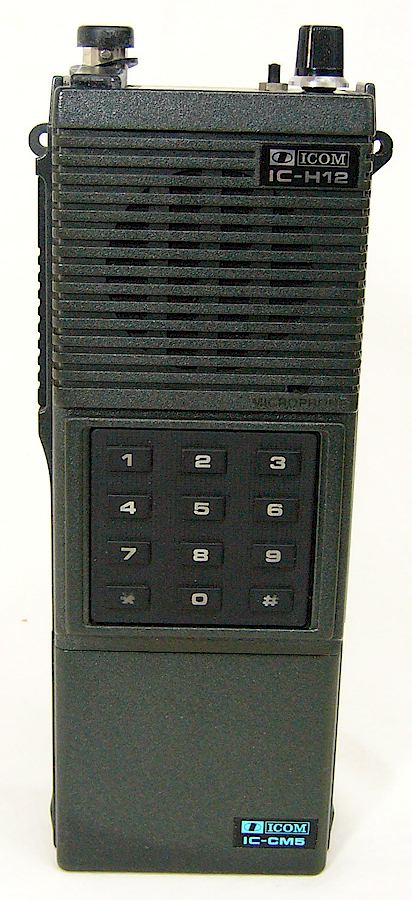
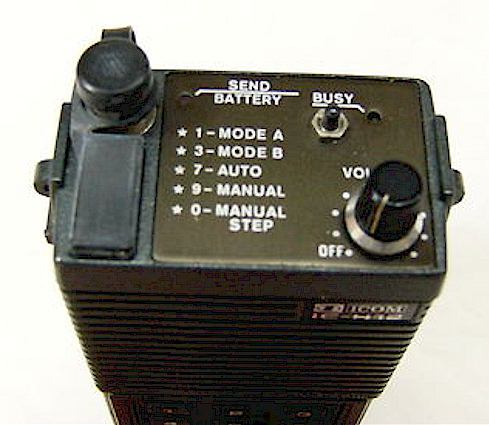
YAESU FTC-2640:
Despite working for a Yaesu dealer in 1982-84 when this item would have been marketed, I had never heard of it until one showed up on eBay in April, 2011, new in the original packing! This appears to be a VHF IMTS mobile telephone which probably used much of the logic package design of the Traveler above. It is not known whether this was a genuine full duplex mobile telephone or just a half-duplex item as was the Traveler above. Further information is needed!
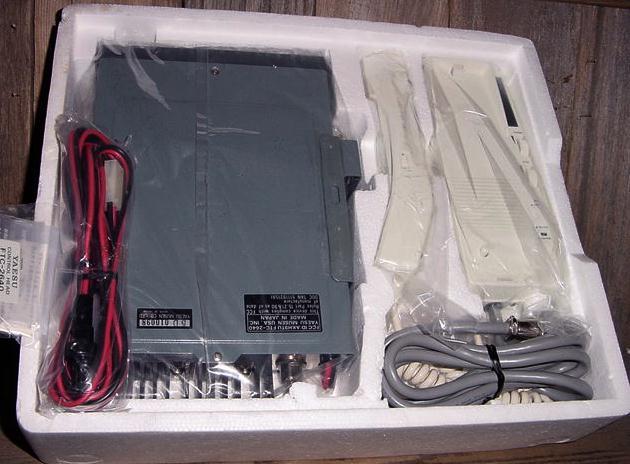
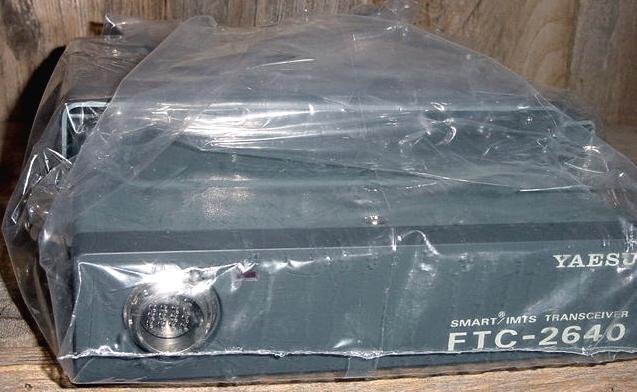
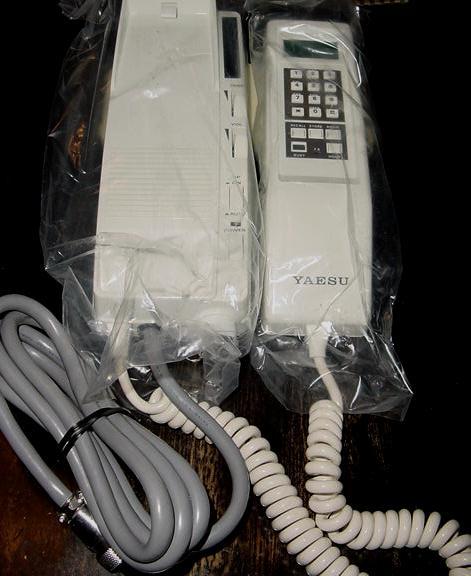
UNIDEN HANDHELD IMTS:
Uniden manufactured a hand-held IMTS radio similar to the Yaesu Traveler unit above, in approximately the same time frame, although I have no other information on it and no photo. It appears that Yaesu was the only manufacturer which committed itself to a rather extensive advertising campaign, as mentioned above. Uniden appears to have preferred to market logic packages and telephone subassemblies to other manufacturers, to be badged with that manufacturer's logo.
NOVATEL AURORA:
International Systcoms appears to have been merged into or bought by Novatel, and their last product, the "µ-Classic," became the Novatel "Aurora." The Aurora was essentially an upgraded Systcoms "µ-Classic" unit as shown above, but came with a different, "cellular-looking" control head, and the connectors on the RF package were changed to more conventional ones which were the same as used on some early AMPS cellular RF packages. The internal circuitry was probably also somewhat upgraded from the Systcoms equipment, and this telephone dates from approximately 1984. The Aurora was unique in having multiple electronic ring tones available, including a musical one. The final version of the Aurora, in the mid 1980's, offered a "piggyback" cellular unit consisting of the AMPS model Aurora cellular RF package on top of the Aurora IMTS RF package. It is unknown if a UHF Aurora was ever manufactured.
CLICK HERE FOR MORE PHOTOS OF AURORA
TRANSCON TC-105 and TC-102 MOBILE TELEPHONES:
Transcon was a Canadian based firm which briefly marketed a VHF mobile telephone with an RF package manufactured in Taiwan, which appears to be a conventional dash-mounted radio modified to be full duplex, with IMTS signaling. The Transcon signaling logic and control design is an outgrowth of that originally created for the Xilex mobile phones, the Transcon equipment being actually the final design of the Xilex product (see Xilex above.) Transcon was started by Fred Ashe, who originally worked at Xilex. The Transcon phones were a rather peculiar arrangement where the transceiver package was apparently intended to be under-dash mounted rather than the trunk, although it would technically be possible to trunk mount them with an extension cable to the handset. The Transcons were described in sales literature as requiring a "technician handset" to be programmed, although it turns out that there is a "program" switch on the internal circuit board which if set, allows the existing handset to program the unit. The connection to the handset was made with a "modular" style telephone cable. The small size is quite an improvement compared to the monstrosity of mobile phones such as the Pulsar II and III from Motorola being offered at the same time, although the Transcon can not be secured from theft (other than that it is in the trunk.)
The TC105 and TC102 differ in terms of the feature set, memories and similar options, but are almost identical. It is unknown whether the Transcon phones were ever actually made in UHF versions. The radio circuitry appears to have been manufactured by Uniden.
Interestingly, the Transcon radio internally generates dial tone as soon as the handset is taken off the cradle, rather than opening the handset audio line to allow dial tone audio supplied from the telephone company IMTS terminal once the mobile ANI has been processed and approved. This has the disadvantage that it is impossible to gauge the signal quality coming from the land terminal, and can also give a false sense of security as to where dial tone might be available. Picking up the handset gives a nice, clear dial tone when it's possible there is no signal at all! A number of Transcon units were purchased by regional Bell operating companies in the final years of IMTS, for use by service and employee vehicles, after Motorola and GE were no longer supplying equipment. For example, the Transcon units were used by Pacific Bell employees and IMTS field service vehicles through 1995.
I have some unused brackets for these in stock (somewhere)! If you need one, let me know.
PACE LANDMASTER :
Pace, primarily a CB and scanner equipment manufacturer, briefly attempted in the mid-1980's to market a synthesized IMTS radio telephone called the Landmaster 3. It was available in VHF or UHF models and used a Phelps-Dodge "flat pack" duplexer mounted underneath the radio package in a somewhat crude manner. It was similar in appearance to the Transcon radio and is doubtful that many were manufactured. At least two control heads were sold, one appears to have been a re-labeled EF Johnson IMTS self-contained head, while a later version used a Glenayre GL-2021 relabeled with the Pace logo, as shown below.
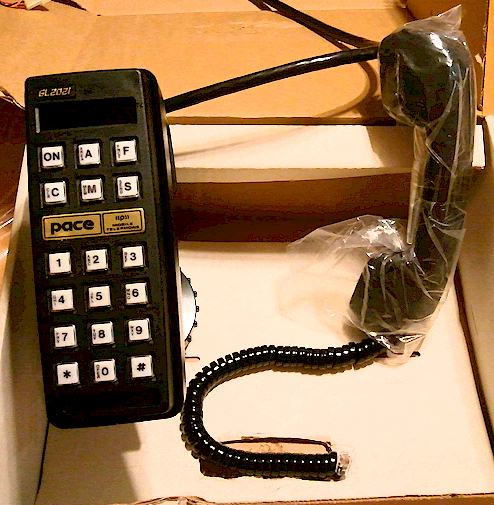
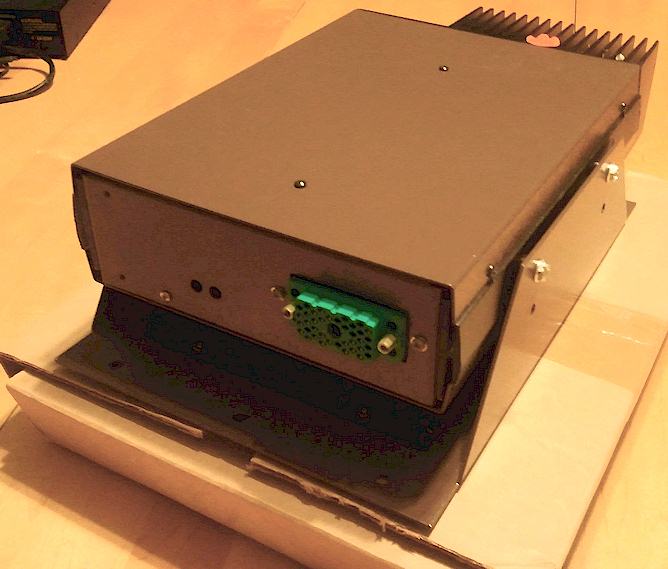
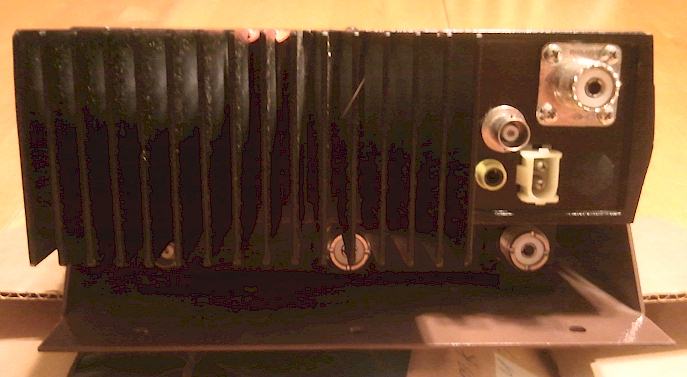
GLENAYRE:
Glenayre, the Canadian based company described previously, made a final model IMTS and cellular combination telephone in approximately 1986, consisting of two radio packages (one IMTS and one cellular) piggy-backed together and feeding a Glenayre GL-3000 control head. [Photos to follow]
HARRIS ALPHA 2000 :
Harris, mentioned previously, offered their final IMTS mobile telephone as the Alpha 2000 series. The Alpha 2000 was a very advanced and superbly made high power mobile unit with a built-in supervisory package which used a control head identical to that used on the earlier "Alpha 40" equipment, other than a slightly different keypad overlay with a couple of different functions. That control head, which appears identical to a standard AMPS cellular phone head of the mid-1980's, used a serial communication line to control the supervisory package in the radio. The original Alpha 2000 was programmed with a "suitcase" style programmer which used "one time" 32x8 "proms" as used in first generation cellular phones. See my page on car telephone test and programming equipment for a photo of one. The Alpha 2000 "E" model utilized a re-programmable EEPROM chip to hold subscriber ID and other information, but required a different programmer, consisting of an Epson HX-20 computer and printer plus some interface hardware. The Alpha 2000 was made for VHF and UHF systems, and a UHF TV-channel sharing model was also made for a number of "Metro" 470 MHz mobile telephone systems apparently unrelated to the Bell System or one-of-a-kind FCC authorizations. The Alpha 2000-ET had an extra socket on the front with provisions for stacking a Harris cellular transceiver on top, for those customers who needed both capabilities. This socket was located below the normal power and control sockets, on the underside of the handle.
Alpha 2000: Original model, uses 32x8 one-time PROM chip for programming
Alpha 2000E: Same as Alpha 2000 except upgraded logic circuitry uses EEPROM chip for programming
Alpha 2000ET: Same as Alpha 2000E except includes interface for 800 MHz cellular transceiver stacked on top
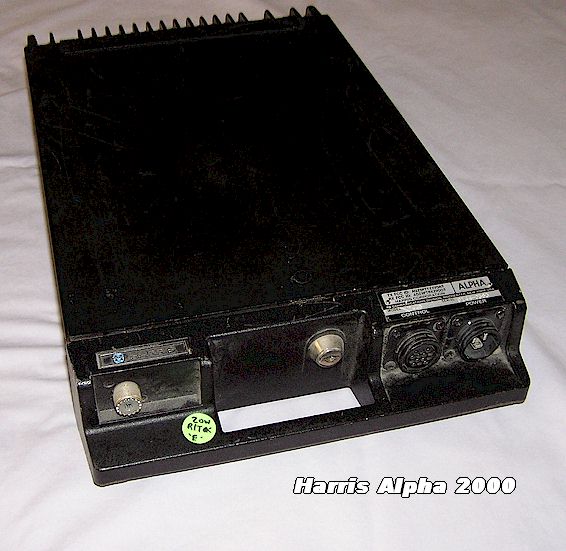
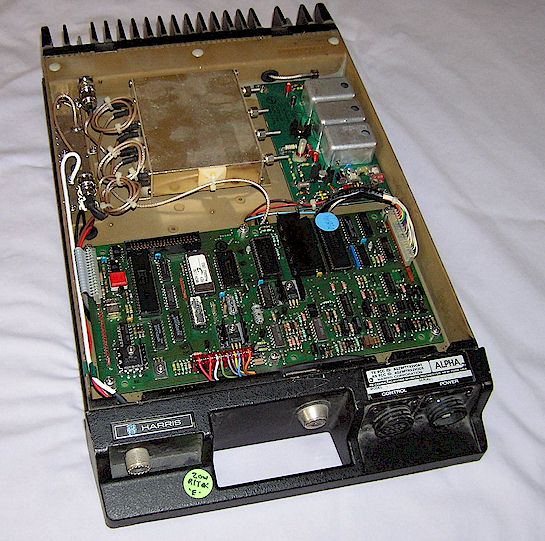
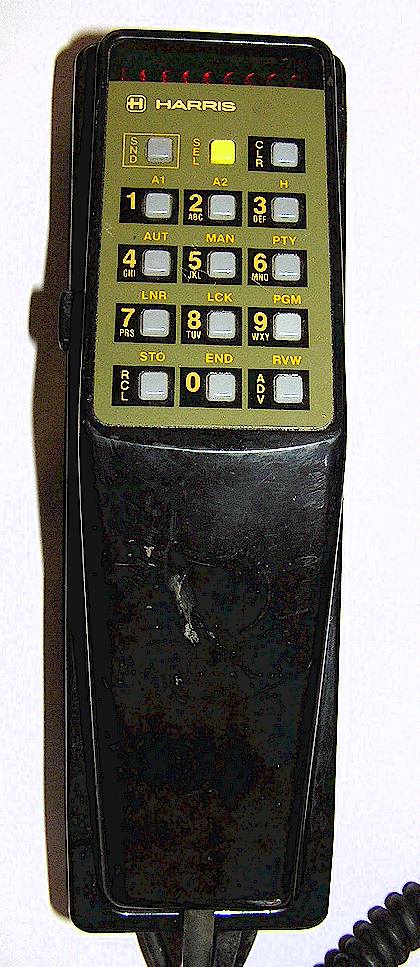
MOTOROLA PULSAR III:
The Motorola Pulsar III was not really a new product, but rather a modified Pulsar II RF package with a Dyna-Tac 6000X cellular handset instead of the standard Pulsar II accessory set. The Pulsar III was also available after 1983 as a combination IMTS and Cellular package, with switching between the two. The cellular section was provided by a Motorola Dyna-Tac first-generation AMPS cellular RF package. Both the Dyna-Tac and the Pulsar III were modified from stock to accommodate the dual operation. There was a standard Pulsar III unit for IMTS only operation, and a slightly different one which allowed interface with the cellular RF package. The model numbers were either T- prefixed as the Pulsar series usually were, or F33EDA--- as the alternate number. A field conversion kit was available to convert the "standard" Pulsar III to the cellular capable version. It is believed that few were made in either configuration. In approximately 1988, Motorola briefly advertised both versions at a deeply discounted price for direct sale, in the classified pages of Communications Magazine and probably other venues, as "the last ones."
The radio drawer package for the Pulsar III / Dyna-Tac is the same as the Pulsar II radio shown above, other than some internal changes.
Shown below is the combination IMTS / AMPS Cellular package radio drawer set. The Dyna-Tac first generation cellular RF drawer is mounted on top of the VHF IMTS Pulsar III drawer. The cable set shown above hooks the whole thing together.
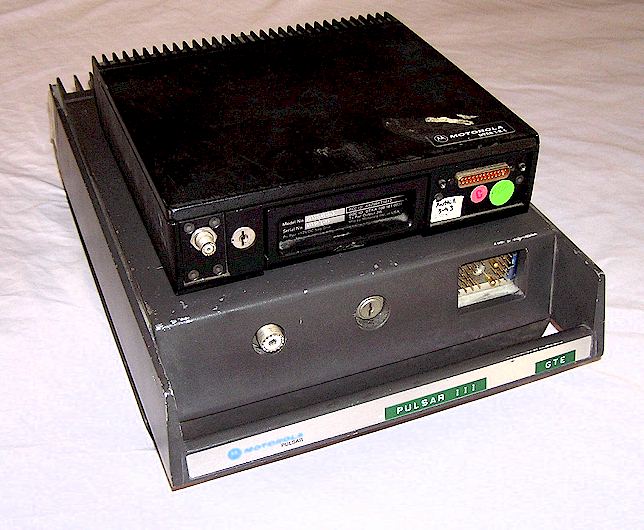
SPILSBURY:
Spilsbury was a highly regarded pioneer Canadian manufacturer of HF portable radios for logging and wilderness forestry applications, beginning as Spilsbury and Tindall. It ventured into the mobile telephone market in the late 1980's making at least one small, modern duplex RF package, evidently without a control head. They were used usually with the Glenayre GL-2020 and GL-2021 control heads in the United States, and possibly with GL-3000 series heads at the end of production. These radio packages were made in both VHF and UHF versions and were popular with RCC's and independent IMTS car telephone dealerships. They were also made for Canadian Autotel or BC-Tel systems which were very similar to IMTS and operated on the same channels, but those used the GL-2031 and GL-2035 heads from Glenayre. Spilsbury was bought out by another concern in the early 1990's and is no longer in business.
CALIFORNIA IMTS SYSTEMS
Pacific Telephone and Telegraph, which became Pacific Bell after the divestiture, ran the largest mobile telephone system in the world, with over 12,000 subscribers at its peak. Until 1982, the system was not remarkable and far from progressive, remaining MTS with all calls being processed manually. At the end of 1982, the system had finally converted to IMTS with seven digit mobile numbers. Pacific Bell was likely the last major mobile telephone system to convert to IMTS. Pacific Bell began IMTS with the conversion to a Motorola EMX mobile telephone computer system, which involved two massive mainframe computers and switches which controlled the entire statewide mobile telephone service. It called its service "IMTS-B." One EMX was located in Anaheim, California, and the other was in Sacramento, California. All signaling and mobile telephone traffic, by necessity, now had to be carrier-trunked to either Sacramento or Anaheim for processing. Any major problems with the centrally controlled EMX system resulted in service failure for an entire half of the state. The EMX, a multi-million Dollar system, was in many respects a failure, more so as it aged. The only other EMX of this type ever sold was for a mobile telephone system in Abu Dhabi, although delivery was canceled and it was never delivered. A similar EMX was sold for a secret government system in South Korea. It has been related that the flaw in the EMX system was the original software, in that third party software for the same functions as that supplied with the EMX by Motorola, functioned flawlessly.
The EMX offered many advanced features such as "follow me roaming", "call waiting,", and 911 emergency call routing (but to a central 911 center staffed by Highway Patrol dispatchers, far from the location of the mobile). In practical terms, most of these features never worked properly or were never implemented. Voice transmission quality through the system was poor, particularly the mobile to land circuit. Mobile callers sounded like they were calling from another solar system, and a typical failure mode would be for the EMX to still process call routing, but fail to complete the audio circuit, or have audio available but fail to complete the call routing.
Pacific Bell appears to have spent its entire mobile telephone budget on the EMX switches, allowing the balance of the system to fall into disrepair and dilapidation. The radio equipment at the land stations still used the early 1960's vintage Motorola receivers left over from the old MTS system, and hybrid Motorola high power transmitters from the same era remained as well. Field service technicians reported such conditions as outside mounted receiver cabinets being full of rainwater due to deteriorated gaskets on the cabinet doors, transmitters running at a fraction of their power output capabilities due to worn out tubes and power supply malfunctions. At any given time, one or more of the voting receivers used in wide coverage systems would be malfunctioning, or supplying audio to the system at a vastly different level than the others. As a result, subscribers began to migrate to cellular service as soon as it was available, and Pacific Bell then began to complain that the IMTS system was "not profitable." This author pointed out to them that no system could be profitable if no subscriber could process a call due to equipment malfunctions, but this seems to have fallen on deaf ears.
Pacific Bell "officially" terminated all IMTS service in May, 1995, after extending the termination date several times. On the last "official" day of IMTS service, the system in Northern California was operating so poorly that it is doubtful anyone could have completed a call anyway. A check of the Southern California system several weeks before "the last day" revealed a complete inability to get dial tone on any IMTS channel run by Pacific Telephone from San Diego to San Luis Obispo. A check of the IMTS VHF channels in Northern California the week after the "last day" turned up the surprising fact that the system was still on the air, and a number of mobiles were using the system! A call to Pacific Bell resulted in the response that employees and company mobiles were still using the system, but that all public customers had been disconnected. This was in fact not true, in that a check of all active mobile numbers in my county showed several private customers still answering and being able to process calls. The reason for this remains a mystery; possibly there was some confusion in deleting active mobile numbers from the database.
At the end of May, 1995, the Pacific Bell IMTS system was taken off the air in its entirety. For a few weeks afterwards, automatic CW identifiers brought up all of the transmitters and identified them with a string of callsigns, every ten minutes, then dropped the carriers. After about a month, that activity ceased also. Today, the channels are vacant and largely quiet. In the late 1990's, many channels were re-licensed to paging companies, but as pagers became passé and the paging systems were taken down, the channels were once again reassigned, in this case to conventional land mobile users such as law enforcement, which in California is currently wasting the spectrum space as unused "mutual aid" channels.
Of note is that the California GTE (and former Con-Tel) IMTS systems survived longer, as well as having started with IMTS before Pacific Telephone did. The Los Gatos, California GTE system was still on the air in 1997 although it is believed that virtually all IMTS systems on Bell channels are off the air today in the United States. There is still at least one IMTS system still on the air, the Schuylkill Mobile Fone, Inc. UHF IMTS private system in Pottsville, Pennsylvania. There are at least a couple of IMTS rural radiotelephone systems operating in remote areas of Canada ( as of 2008) although I understand there are plans to replace those with "micro-cell" GSM stations.
An interesting note is that in approximately 2001, the FCC began auctioned the long-abandoned low band 43 MHZ "Z" series MTS channels originally occupied by Pacific Telephone and other Bell operating companies on the western coast from Alaska to Mexico. These channels were purchased for small sums, relatively speaking, by a number of small business and individual purchasers, but a use for them was never actually determined and it seems that most buyers eventually lost the licenses for failure to make use of them.
Click here to see some old Pacific Telephone mobile bills
POSTSCRIPT:
If you are interested in mobile telephone history, I would like to hear from you. Also, if you have a Bell or independent Telco IMTS or MTS car telephone system still operating in your vicinity, I would especially like to know about it. I am looking for many MTS mobile phone items to add to my "museum" and for photos on this web page. I specifically would like to find service manuals for any Canyon Communications products, service manuals for any late Systcoms products, service manuals for Novatel Aurora IMTS VHF car phones, Western Electric 41A series control head parts, smaller IMTS radiotelephone terminal equipment, advertising literature, Bell System Practices publications on MTS and IMTS radio telephones, service manuals for and examples of Motorola Motrac - Motran and Micor "Z" channel lowband equipment, any ITT mobile telephones, any Symetrics mobile telephones, and much more. If you have any photos of early car telephones, please share them, credit will be given. Help save this history from going to the dump! I would also like to hear from any foreign visitors to this page, who might have information about vintage radio telephone systems in their country.
This page maintained by Geoff Fors, WB6NVH. You can E-mail me at the address shown on my home page.
Ver. 7/30/20021 © Geoffrey C. Fors, 2005 All rights reserved